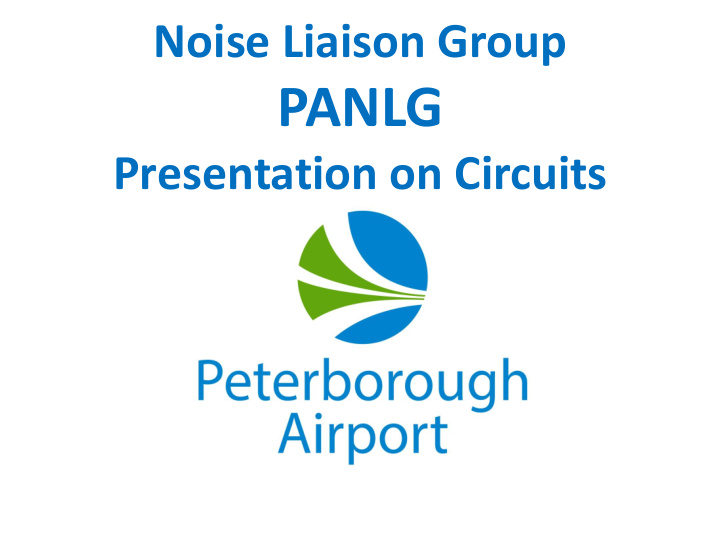



Noise Liaison Group PANLG Presentation on Circuits
THE CIRCUIT PATTERN
Slide 2- The Circuit Pattern Circuit training is the first stage of practical pilot training focused on take-offs and landings. It involves the pilot making approaches to the runway, touching down and then applying power to take off again. Circuit training is undertaken at most airports, particularly regional and general aviation aerodromes. Training during both day and night is important for developing pilot competencies, as is experience with using different types of navigational aids. A circuit consists of five legs – the take-off, crosswind, downwind, base and final approach to the runway. A simplified representation is shown in this picture. The take off and final stage of the circuit is flown into the wind, as this is the safest way for an aircraft to operate.
Left Hand Circuits
Slide 4 – Left Hand Circuits The picture depicts a left hand circuit with the aircraft turning left after take-off and flying anticlockwise. This is the most common type of circuit operation. The pilot is seated on the left side of the aircraft, it makes sense that if you do a left hand circuit, and the airfield remains to your left, that you, as the pilot, will have the best view of your landing path, no matter where you are in the circuit. Arrival paths in the circuit have been designed to give pilots the best visibility of other aircraft in the circuit or approaching the airport from outside the circuit. Transport Canada rules for VFR circuit procedures at uncontrolled Mandatory Frequency Area aerodromes (Peterborough) states, that incoming aircraft make all descents to the circuit altitude on the upwind side, then cross the aerodrome at mid-field, at 1000 ft above aerodrome elevation (AAE) or at the published circuit altitude. Aircraft may also enter the circuit from the downwind, only if no conflict exists.
Aircraft Noise Impact
Slide 6 – Aircraft Noise Impact The circuit length, and therefore the area over flown, depends on how quickly the aircraft can climb to the required height for the downwind leg. This circuit varies between aircraft and is affected by meteorological conditions (including wind, cloud cover, and temperature), other aircraft in the circuit, and pilot proficiency. The size and location of the circuit is to ensure the safety of all aircraft operations at the airport. This may result in flying being undertaken over populated areas, especially where these are in close proximity to the aerodrome. The picture above shows typical variations in circuit pattern. The yellow circuit depicts circuits when the wind is blowing from the north, whereas the green circuit depicts circuits when the wind is from the south.
Dealing with Winds Example of what a crosswind might do to a circuit pattern
Wind Correction Methods The aircraft needs to be in a position, at just the This is NOT an easy right angle to keep the task! The winds are leg heading, and not steady in speed anticipate the changes or direction, and tend required for each leg to increase and veer flown. with altitude.
Landing with Winds Various methods used on the final leg to land the aircraft in a crosswind Crabbing (angled into the wind until near touchdown Slipping (approach the runway straight on, with the into-wind wing lower
Slide 11 – Noise Abatement Procedure On July 4 th 2017 the Peterborough Noise Abatement Procedures came into effect with the issuance of a NOTAM. -No turns below 1000 feet above aerodrome elevation on take-off and climb from runways 09 & 27 If/when possible, avoid over flight of noise sensitive areas – marked on the map
Runway 27 Circuit Variations Example
Slide 13- Runway 27 Circuit Variations Example Runway 27: Aircraft taking off from runway 27, climbing to circuit altitude (1000’ Above Airport Elevation) before turning crosswind. The black line indicates the new standard circuit pattern guideline. The white line encompasses the different circuit pattern variations.
Runway 09 Circuit Variations Example
Slide 15- Runway 09 Circuit Variations Example Runway 09: Aircraft taking off from runway 09 from the intersection at the taxiway Hotel, climbing to circuit altitude (1000’ Above Airport Elevation) before turning crosswind. The black line indicates the new standard circuit pattern guideline. The white line encompasses the different circuit pattern variations.
Questions?
Recommend
More recommend